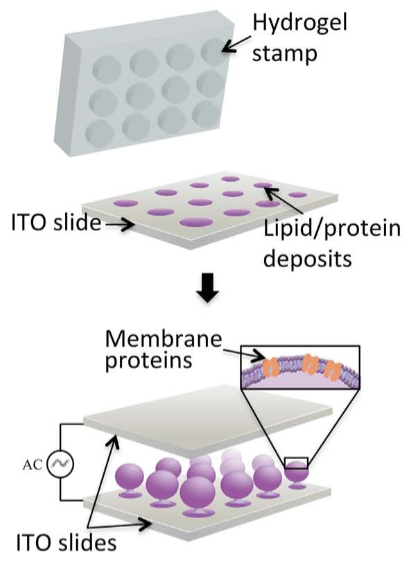Microprinting low-cost artificial cells
Could serve as drug and gene delivery devices
December 19, 2013
[+]
Easily manufactured, low-cost artificial cells manufactured using
microprinting may one day serve as drug and gene delivery devices and in
biomaterials, biotechnology and biosensing applications, according to a
team of Penn State biomedical engineers.
Schematic
representation of production of arrays of controlled-size artificial
cells by combining hydrogel stamping and electroformation techniques
These artificial cells will also allow researchers to explore actions that take place at the cell membrane.
“In a natural cell, so much is going on inside that it is extremely complex,” said Sheereen Majd, assistant professor of biomedical engineering. Understanding how drugs and pathogens cross the cell membrane barrier is essential in preventing disease and delivering drugs.
“With these artificial cells — liposomes — we have just the shell, which gives us the ability to dissect the events that happen at the membrane.”
Artificial cell arrays
Researchers have created artificial cells for quite some time, but Majd’s team is creating large arrays of artificial cells, made of lipids and proteins, of uniform size that can either remain attached to the substrate on which they grow, or become separated and used as freely moving vessels.
“The trend in the pharmaceutical industry today is that they like to do high-throughput screenings,” said Majd. “They could use a large number of these artificial cells all of the same size with the same conditions in an array and monitor many cells at once.”
The researchers’ cells are also different because they contain lipids with protein components, the way cell membranes exist in nature. The various proteins serve to allow certain materials to enter and leave the cell, acting as regulators.
“These giant proteoliposomes closely mimic cellular membranes,” said Majd. “So they are excellent model systems for studying processes that happen at the surface of cells such as the molecular events that occur when pathogens and drugs enter cells.”
Older methods of artificial cell creation used dried lipids, but to create cells with proteins, the system must remain moist because when proteins dry out, they become useless.
How to create an artificial cell
Using hydrogel stamping, a process that creates a stamp out of wet hydrogel that deposits dots of the lipid and protein mixture on the surface of the substrate, the researchers can lay out an array of potential artificial cell locations. They then apply an AC electric field to the substrate. Where the lipid and protein mixture exists, tiny bubbles form that eventually combine into one artificial cell. The result is an array of artificial cells neatly placed and spaced on the substrate.
“The AC electric field produces agitation that creates the tiny bubbles that merge to form the cells. This process is called electroformation,” said Majd.
The variety of lipids and proteins used can vary depending on the ultimate purpose of the artificial cells. The cells that form are between 20 and 50 microns, within the range of natural cells.
“The beauty of this method is that a lot of labs already use liposomes and electroformation,” said Majd. “However, traditionally, they do not have proteins attached.”
Another problem is the traditional method creates artificial cells in tens of sizes situated all over the place, she added. Other methods require complex devices such as microfluidics to create uniformly sized artificial cells. With the hydrogel stamping method, it is easy to control the size of artificial cells and to generate a large number of these cells efficiently.
The researchers would next like to incorporate more than just lipids and proteins into the artificial cells. One possibility is to bind potential drugs to the proteins and lipids.
The Charles E. Kaufman Foundation at the Pittsburgh Foundation helped support this work.
Abstract of Advanced Materials paper
S. Majd and co-workers report a simple approach for the preparation of cell-sized liposomes with integral membrane proteins on page 6834. In this approach, hydrogel-stamped lipid/protein deposits grow, upon application of an AC electric field, into giant liposomes of controlled size and composition. The resulting vesicles can be applied in membrane and protein studies as well as in biotechnology.
(¯`*• Global Source and/or more resources at http://goo.gl/zvSV7 │ www.Future-Observatory.blogspot.com and on LinkeIn Group's "Becoming Aware of the Futures" at http://goo.gl/8qKBbK │ @SciCzar │ Point of Contact: www.linkedin.com/in/AndresAgostini
 Washington
Washington